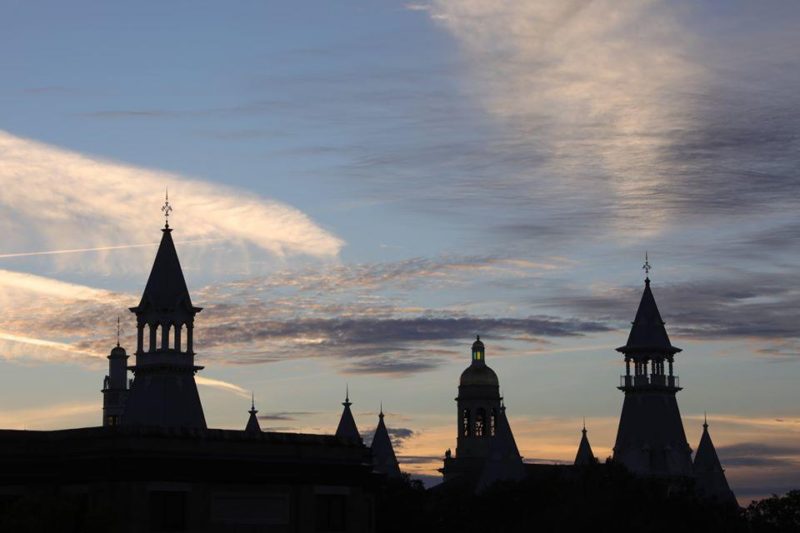The 3.7 million high school students who graduated in 2020 faced a troubling dilemma: Should they risk their health (and the lives of their aging relatives) by enrolling in fall classes which might be hosted on Zoom, or should they take a gap year in a world where everywhere but their parents’ basements might close its doors?
Students are not the only ones with these concerns; parents, too, have to decide if they should pay, on average, five-figures in tuition and fees for classes presented in their living rooms. Because universities have become America’s primary vetting institution for joining the upper middle class, most parents will probably decide to foot the bill.
On an individual level, that might be the most rational choice. But policymakers looking at the bigger picture should ask a different question: Is a regime that demands so much from their constituents the best option, or just the only available one?
University budgets have faced some pressures in recent years, even before the coronavirus pandemic, but the universities have never lacked advocates — not only in Congress and state legislatures, but also chambers of commerce. However, the last three months of COVID strictures and quarantines have brought into stark relief how badly higher education needs to be reformed.
The university model that we have today originated in the Middle Ages. The Medieval university came about to ensure students would only receive their credentials after they paid their tuition bills. (Prior to this, students received their lessons from independent instructors who were often cheated out of their pay, which, by custom, they received on the last day of class).
Aggregating knowledge into central locations also helped students to access costly books and information. But technology has rendered these concerns obsolete.
One area of innovation, of course, is online learning. But face-to-face interaction is still the most dynamic environment for exchanging ideas and asking questions. That does not require a classroom. Public officials should develop a regulatory scheme that would allow faculty to teach in any public space. Instructors with certifiable credentials should be as free to teach an accredited college course in the private meeting room at Starbucks as they are in an austere lecture hall at Stanford. Imagine a world in which registering for an accredited introductory writing course were as easy as hailing an Uber driver.
Tenured faculty will not embrace the idea, and it will be fought every inch by battalions of university administrators and staff. Corporations will try to maintain the professional development subsidies that state-sponsored education provides. But government should prioritize the needs of those who currently need help the most—the parents who are seeing their savings dwindle and their kids, the students who are being asked to take on ruinous debt.
The idea of decoupling faculty from institutions isn’t just my idea. Legislation presented to Congress has recommended this very thing. Senator Mike Lee’s proposed Higher Education Reform Opportunity (HERO) Act would take accrediting powers away from academic monopolies like the Higher Learning Commission (HLC), the Commission on Accrediting of the Association of Theological Schools or the American Bar Association and would give these powers to state agencies—the California Department of Education, the Texas Education Agency, the Montana Office of Public Instruction, etc. Under the new guidelines, these agencies would be able to draft higher education models which serve their needs and reach their communities, urban and rural.
Students might be slow to embrace new models and parents will be wary of classrooms taught anywhere outside of the staid halls of brick and mortar institutions. But adjunct positions now constitute over 75% of faculty jobs, and it’s probably a safe bet that a part-time literature professor can teach a class on the Victorian novel just as well in a church basement as in a lecture hall.
As alternate models become de rigueur, higher education will find customers it never expected to have: The retiree who got the paralegal certificate for her career, but now wants to write short stories; the farm kid who never wanted to leave Iowa, but has always been curious about analytic philosophy; the parolee who wants to make a fresh start but can’t square the community college schedule with the required social worker meetings.
Reaching the point where the public sees this model as a reliable alternative will take time; it will require entrepreneurial academics to lead the way and a new cohort of faculty who are willing to teach in a setting they never imagined. At the very least, government can let the future leaders of higher education know that they are wanted.
Higher education will not look the same after the fall of 2020; some colleges may fail, and some academic programs may be cut. Now is the time to ask if we can do better, not just during the pandemic but for the generation charged with rebuilding the world the pandemic leaves behind.
